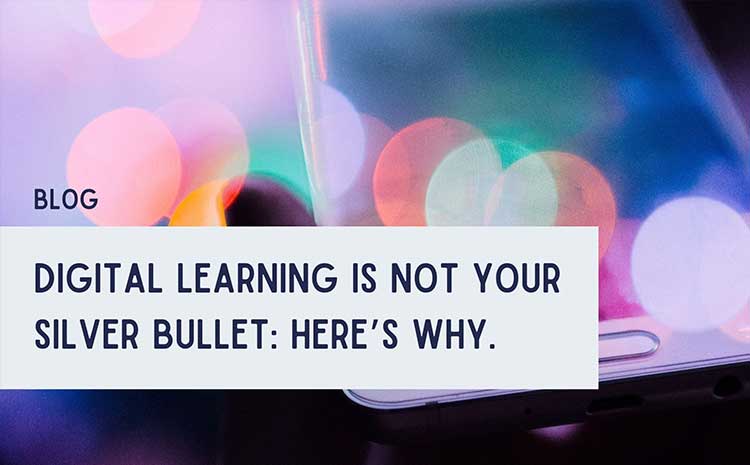
- September 2, 2021
- bluesky
- 0 Comments
- Team Building & Engagement, Virtual Learning
Digital Learning is not your silver bullet: Here’s why
When organizations scale up and grow in size, reaching out to the entire population becomes a challenge. While emails, internal messaging systems and town halls address some part of the communication and engagement, how do you make learning effective for large audiences?
One of the easiest and most logical solutions is digital learning solutions. Signing up for these ready platforms provides organizations with a plethora of content on various subjects and provides the onus of learning to the end-user. They are not restricted by time, or place and can learn at their own pace.
Added to this, with remote working becoming the accepted way of working, digital learning surely seems like the way to go!
Digital learning is surely gaining popularity as employees get technologically savvy and organizations are looking for easy ways to scale learning initiatives globally. Byond just organizations, digital learning through MOOCs are becoming ever more popular. Want to learn science? Art? How about music? Or AI or technology. There are digital learning solutions for everything.
The real question however is how does the trend towards digital learning help results? How does this work for more tricky areas like behavioral skills? Let’s explore.
But how effective is it?
Though this model might work well for functional knowledge transfer, there are many challenges that digital learning poses when it comes to behavioural skills; as most of this is common sense and there is often a gap between knowing and doing.
Change is hard to make and habits are even harder to form.
Here are few reasons why digital learning might not be the answer to every learning initiative:
Lack of Engagement

The same is true for adult learning too. While learning at your own pace has its own benefits, learning journeys can get lonely without having others as a company and often can result in a lack of engagement. As a result, learners might start a course enthusiastically but fail to complete it. The industry studies suggest that online course completion rates are abysmally low – as low as 5-15%
Knowing not Doing

Behavioural skills need reflective sessions so audiences can pause, question and change their behaviours based on their own understanding. This might require a facilitator, a mentor or a moderator to help the process.
Missing Contextualisation

For example, let us look at communication as a learning theme. It will look different for salespeople, whose entire role, revenue and conversions depend on how well they communicate. But let’s say, an accounts person or a research assistant is taking the same course – while they also need this quintessential skill, their job roles offer them a slight buffer as they sometimes can get some of their work done in silos. And when they do collaborate with others, it is more from a knowledge-sharing standpoint. Without contextualising, communication as a generic subject cannot be doled out to everyone as it will make little sense.
Large Libraries, Little Meat

But all knowledge is useful if it is not applied. And this one last step is often missing in the learning loop. The end-user might end up with a lot of bookish knowledge, or in other words, ‘the what’ but might lack knowledge of ‘the how’ – how to apply this in their job roles, how it applies to them, how they can practice it, how they can make it a habit, etc.
No Human Element

Not all learners are alike. Some of us might prefer reading and learning while others prefer an audio, visual medium. Though the online platforms cater to different kinds of learners, the lack of a human element to connect the dots, contextualise, or help glean insights often hinders the learning process, to the extent of increasing the dropout rates.
Conclusion: So, what is the solution?
The best way to do this is to create a blended approach.

Give access to your employees to your digital portals and learning repositories while enabling and empowering managers and leaders to conduct some in person or at least virtual sessions to make the learning more engaging and sustainable. This ensures that you can cover the more critical aspects in an engaging, interactive classroom environment while digital learning fills the gaps and reinforces learning. Learning is not something that is easily measured. It takes a lot of effort and a long span of time to properly assess the impact of a learning initiative. But the most obvious levers we have are learner engagement, ensuring there are opportunities for peer to peer learning, especially for behavioral skills as it is not something that can be easily understood through videos or online courses. Actually working with people and socially interacting with them and learning from each other is the way. A blended approach gives you scale but also lets you dig deeper and have more focused learning around behavioral skills that are strategically important, like your leadership competencies or values. Remember to think, plan and be prepared so you can successfully close a full learning cycle. Good luck!
If you are looking for blended learning initiatives or need help planning what you have in mind, talk to us at BlueSky Learning. We have activities for small and large teams and can meaningfully engage teams in exciting activities and challenges while focusing on specific learning outcomes.
Author: Deepthi Boddupally
